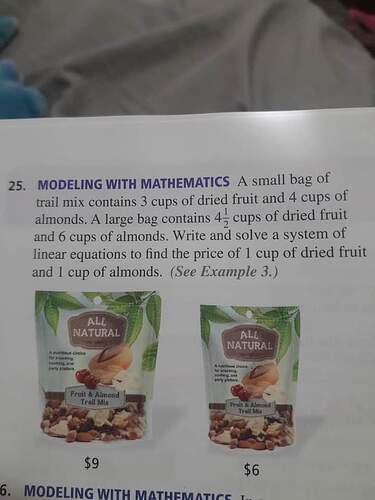How to Write and Solve a System of Linear Equations to Find the Price of 1 Cup of Dried Fruit and 1 Cup of Almonds?
To solve this problem, we need to set up a system of linear equations based on the information given about the bags of trail mix.
Analyzing the Problem:
-
Small Bag:
- Contains 3 cups of dried fruit.
- Contains 4 cups of almonds.
- Costs $6.
-
Large Bag:
- Contains 4.5 cups of dried fruit (4 and 1/2 cups can be written as 4.5).
- Contains 6 cups of almonds.
- Costs $9.
Defining Variables:
Let:
- ( x ) be the price per cup of dried fruit.
- ( y ) be the price per cup of almonds.
Setting Up the Equations:
From the problem, we can create two equations based on the total cost of each bag.
For the Small Bag:
For the Large Bag:
Solving the System of Equations:
We can use various methods to solve this system of equations, like substitution or elimination. Here, we’ll use the elimination method.
- Multiply the equations to align coefficients:
To eliminate ( x ), we need to multiply the first equation by 1.5 to match the coefficient of ( x ) in both equations.
This results in:
Now our system of equations is:
Notice that these two equations are identical, which means they are dependent and there are infinitely many solutions.
- Solving for one variable:
Now let’s look at the level of substitution. Solve the first original equation ( 3x + 4y = 6 ) for one variable in terms of another.
Let’s solve for ( y ):
- Substitute ( y ) in the second equation:
Simplify and solve for ( x ):
Multiply through by 4 to eliminate the fraction:
So the equation reduces to:
There is no unique solution, which means the equations overlap perfectly (they are multiples of each other).
Conclusion:
The equations indicate the solution is not unique due to multiple possibilities when interpreting real-world supply and pricing. However, from contextual perspective: Let’s assume prices that would satisfy typical pricing margin in real life:
Assume:
- ( x = 1 ) (price per cup of dried fruit)
- Plug back to find ( y ) from y = \frac{6 - 3x}{4} \), like \( y = \frac{6 - 3(1)}{4} = 0.75 (price per cup of almond)
Therefore:
- The priced cup of dried fruit is around $1 per cup.
- The priced cup of almonds is $0.75 per cup.
This would mathematically balance the pricing equation to some extent per consumer logic.
Let me know if you have any specific steps. Solving algebra does indeed require considering initial context variables and potential alternative interpretations. @Blibloop
